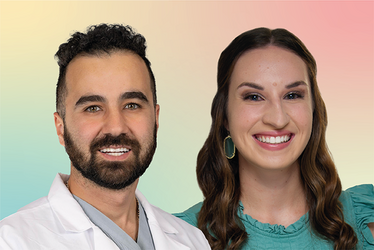“I Learned It from TikTok”
Meet the small-screen social stars who are educating pathologists globally
Georgia Hulme | | 12 min read | Interview

Casem Ballouk's Headshot Credit: Wayne State University School of Medicine - Medical Communications. Kimberly Fiock's Headshot Credit: Tim Schoon at the University of Iowa
When you think about TikTok or Instagram Reels, a particular trend, meme, or dance may come to mind. Creators on these platforms usually put out funny and relatable content for their viewers to enjoy. But who says these videos can’t also be educational?
Here, Casem Ballouk (@surgicalpathology on TikTok, @pathsurg on Instagram), a third year pathology resident at Wayne State University School of Medicine, and Kimberly Fiock (@thepathphd on Instagram and TikTok), a staff scientist at the University of Iowa and Director of the Iowa Neuropathology Resource Laboratory, help us understand how short videos can benefit the pathology community. They also discuss their content creation process, the dangers of misinformation, and their top tips on growing a medical-based platform.
How did you build your large followings? And what inspired you to start creating TikToks?
Ballouk: Reaching 554.2k followers on TikTok still feels surreal. It all began innocently enough, when my friends and I started to create light-hearted, silly videos for fun. We would challenge each other to come up with new, entertaining content. It took a turn when, on a whim, I posted a video grossing a specimen in the lab. The reception was astounding. It wasn’t just my friends who were interested; the broader TikTok community seemed captivated too. My follower count skyrocketed after that video. Realizing the potential and seeing how engaged the audience was, I decided to lean into this niche. And here we are!
Fiock: I have both a master’s degree and a PhD in pathology and have been in the field for the last five years. My research is focused on different neurodegenerative diseases caused by tau, and I use stem cells and human tissue to better understand how one protein causes multiple, distinct diseases. I started my PhD in 2020, during the pandemic, so I wanted to find a community in pathology. At the time, all I could find were MDs posting information for other people in the medical field. Without the same type of training, I struggled to understand what to look for in the images. That’s when I decided to make simplified content that used real examples of pathology with a more broken-down approach to help people outside of medicine learn about the field. When Instagram expanded their platform, I started doing reels, which provided a new way to engage people by showing exactly how a given process happens in the lab.
Talk us through your content creation process…
Ballouk: When I’m at the gross bench or in the autopsy suite, I’m always on the lookout for those "Aha!" moments – things that intrigue or teach. If you think, “Hey, this could spark curiosity or offer some insight,” it’s prime material for a TikTok video. Make sure the video quality is crisp and add some trending audio at a low volume.
Fiock: Before I film anything, I like to write a script of what I want to say. I break it down sentence by sentence, so I can film in smaller chunks. I typically have my principal investigator look over the script to make sure everything looks accurate and is phrased in the best way possible. Once I’m happy, I start filming, which usually takes about an hour for a 60 second video. I usually film 10–12 individual videos that I cut together in an editing software called InShot (though I probably shoot 50 or so clips including the outtakes). I use my phone on a tripod and memorize each line one at a time, so I can deliver it directly to the camera. Once I have all the videos, I put them into InShot and cut off the excess in the beginning and end of each one from starting and stopping. Then I add captions by copying the pre-written script and include photos and arrows to point out specific features when necessary. Finally, I type up a caption and post it! The whole process can take anywhere from two to six hours, depending on the complexity of the video and whether I have to take photos of the pathology I’m discussing.
@surgicalpathology♬ Suspense, horror, piano and music box - takaya
Is there anything you have to keep in mind with showing medical content on videos?
Ballouk: Absolutely. Top of the list is ensuring patient confidentiality; no video is worth compromising that trust. I also try to ensure the content is both respectful and educational. It’s not about sensationalism, but about informing and enlightening. TikTok can be strict, so avoiding blood or gore is crucial. Not only to keep the platform happy, but to ensure viewers get the value without unnecessary shock. A flag or strike on your account can really hinder the message and outreach, so it’s always better to play it safe and smart.
Fiock: I like to use different pictures from multiple cases of the same disease to prevent anyone from identifying a specific person. I also make up all my case histories based on the average or most common symptoms of a disease, so it’s not history from a specific case. Of course, I never include identifying personal information about cases and never offer medical advice in my videos. I tend to avoid showing fresh brains because people can be sensitive to blood, but I know there are creators in forensics who may show blood and be okay!
What advantage does short video content offer over YouTube videos or other long-form content?
Ballouk: Short videos, like on TikTok, cater to today’s craving for quick dopamine hits. They deliver instant gratification by turning complex topics into bite-sized nuggets. These clips are not only more digestible, but their brevity also boosts shareability – increasing their potential virality. In a world where many seek swift content consumption, short videos offer immediate satisfaction, setting them apart from longer formats on platforms like YouTube.
Fiock: Short videos are attention grabbers! I think people turn to Youtube when they want to learn in-depth about a topic, so Instagram is more to get people’s feet wet on a subject. I also like that it’s more of a conversation starter. You can’t possibly cover all the nuances of something in 60–90 seconds, but it opens the door to discuss something further, be it in the comments or in follow up posts.
Do you find any downsides – misinformation, for example – of TikTok when it comes to pathology and lab medicine?
Ballouk: Certainly. The challenge with brief content is that it can sometimes oversimplify, leading to potential misinformation. It’s crucial to be clear and accurate.
Fiock: It can be really challenging to balance the beauty we find in our field with the sadness people experience being connected to disease. I try really hard to not sound too upbeat in videos discussing disease because I know how horrible they are to experience, but you also have to be engaging so people watch the whole video. There’s also a ton of negativity on TikTok in particular because anyone can post anything they want and have it go viral, regardless of how truthful it is. I try to avoid getting bogged down in misinformation busting because it is so mentally draining as a creator.
@thepathphd How a #pathologist makes a diagnosis (full length video)! *Example case history is used with real human #brains* #neuroscience#pathology♬ original sound
Have you encountered any problems as your following has increased?
Ballouk: With a larger audience comes a greater responsibility to share accurate and sensitive content. It’s been a learning curve.
Fiock: As my account has grown, I’ve felt more pressure to constantly produce content to keep up the momentum. I have to remind myself that I have a full-time job, so social media takes the back burner sometimes. In general, people have been really respectful and have enjoyed watching my journey as I’ve grown as a scientist and educator.
Are there any examples of how your content may have helped people?
Ballouk: I’ve received numerous questions from my followers about the field of pathology, with many expressing newfound interest in it as a career.
Fiock: I get messages all the time from people who have decided to pursue a career in pathology, and it honestly makes my heart so happy! I also post quizzes periodically on my account, so people can test their knowledge, and a lot of times they’re correct!
Pathology has struggled to recruit people into the field for a number of years now. How might TikTok be used to help alleviate that and increase interest?
Ballouk: By offering a visual insight into pathology, we can demystify the profession and highlight its significance, attracting potential future pathologists.
Fiock: I think a lot of the struggle with pathology is that it’s a very visual field. If we’re just describing what we do in words, people might not feel connected to the work and choose not to pursue it. But when we show people what we do through videos, I think it makes it much more exciting. People can watch a video and think, “Wow! I could see myself doing that.” I also think people have a misconception that pathology is only about doing autopsies. Showing them different sides to the field helps them realize that there’s room for everyone in many different capacities.
How does TikTok/Instagram allow you to reach new audiences and increase awareness of the field?
Ballouk: TikTok's vast user base gives us a diverse viewership. Each post can educate a segment of the public, guide a student, or even clarify a concept for a patient.
Fiock: I think the algorithm on those platforms can work in your favor in that it’s constantly pushing your content to random people who may not otherwise stumble upon it! So, even if someone has never heard the word pathology before, they could still find your videos without looking for them. I also think people are hungry for knowledge. When patients are first diagnosed, many of them turn to the internet to learn. If we can be a source of information for them, then that’s incredibly special. People want to feel empowered to make decisions about their health, so giving them the tools to understand how we come to a diagnosis or why laboratory testing is so important makes them feel more like a participant in their health journey.
@surgicalpathology#Pathology#SurgicalPathology#GIpathology♬ Past Lives - Dannie Lord
Would you recommend other pathologists to join TikTok or Instagram? How can it help their work and career?
Ballouk: The platform provides an opportunity to network with peers globally and to share and gain knowledge.
Fiock: I would definitely recommend other pathologists try out social media, even if it’s just to see what other people in pathology are doing. Social media is a huge networking opportunity. My career has been exponentially impacted by networking, and it all occurred because people found my account on Instagram and loved what I do. It’s also very satisfying to make a post and have someone comment that they learned something new. There’s no going backwards with social media. You have to get smart about using it in your favor because that’s where people are going to get information from.
In your experience, what type of pathology content gets the most attention on TikTok and Instagram?
Ballouk: Videos showcasing gross content, particularly those featuring cancers, truly captivate the audience. Many people may have come across radiologic images, but the gross visualizations remain a hidden gem. The real allure of pathology is in those behind-the-scenes moments: how we process specimens, orient them, apply paint, and so forth. These intricacies – which are often overlooked – drive significant engagement on the platform. It’s the perfect blend of visual appeal and educational depth.
Fiock: Posts or videos that explain what people should be looking for tend to perform the best. Posting a picture that simply says “this is a tumor” isn’t going to get engagement from people outside the field. But posting a picture of a tumor with arrows pointing out different features and descriptive words that help explain why those features are important will get people to stop. Also, adding in your own personality and creativity will help! Whether that be through pathology art, food that looks like pathology, memes, TikTok dances, and so on. People love relatable content, so finding ways to make pathology more relatable helps!
What are your TikTok and Instagram top tips? Any advice on how to gain traction and reach more people on the platform as a pathologist or medical professional?
Ballouk: Authenticity is paramount; always stay genuine and true to your expertise. Regularly posting content is crucial for maintaining a visible presence. Engaging actively with your followers can be transformative – their feedback can significantly influence the direction of your content. Feel free to adapt from my templates as they might provide a helpful foundation. Though credentials are important, it’s essential to deliver content that dives straight into value. Research suggests viewers decide within 0.6 seconds whether to continue watching or swipe away. Consider incorporating trending music to further engage your audience. It’s beneficial to limit external influences, especially when starting. Concerns about what friends, family, or coworkers might think can stifle creativity. Lastly, resilience is a crucial trait to have in this journey. Challenges will arise, but persistence and remembering your initial motivations can help you navigate them.
Fiock: Keep with it and keep it simple. You’re probably going to only get a few likes in the beginning, but as you continue to post, people will follow! It takes a long time to build a brand, especially as the algorithms constantly change. Also, remember to post content that speaks to you. Avoid getting bogged down in the posts or accounts that emphasize supposed ways of making content to get big. Do what feels authentic to you. Your passion will come through and engagement will follow suit. Finally, try not to focus on the numbers. It’s really easy to feel like you’re not good enough when you judge your account by the number of followers you have or the number of likes on your posts. The people who want to follow you will, and the ones that don’t won’t. That’s okay.
Anything else you would like to add?
Ballouk: I want to say thanks to The Pathologist for this article. If you’re interested in collaborating or think my platform might be a good fit for a particular cause or project, drop me an email or DM. I’m always open to fresh ideas and endeavors!
Fiock: I’m always happy to promote new accounts or offer advice or support! Feel free to reach out if you’re just getting started and need a friend!
Associate Editor for the Pathologist




















